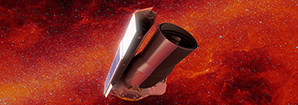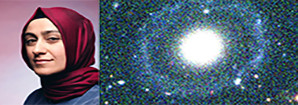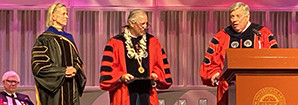Spotlight

Steward Celebrates UN International Day of Women and Girls in Science
February 11 was the UN International Day of Women and Girls in Science. We partially celebrate by creating and posting this collage of the women scientists here at Steward. A larger version of the collage can be seen HERE.

UArizona Staff Say Goodbye to SpitzerSpace Telescope
On Jan. 30 the Spitzer Space Telescope received its final command. After more than 16 years of exploring the cosmos in infrared light, it was switched off permanently, ending its career as one of NASA's Great Observatories. The spacecraft operated for more than 11 years beyond its prime mission.
Spitzer orbits the sun, trailing about 158 million miles behind Earth – more than 600 times the distance between Earth and the moon. Due to the constraints of its orbit, the angle at which the telescope's solar panels point away from the sun has increased with each year, resulting in an ever-shorter time window during which it can communicate with Earth. That window would continue to grow shorter year after year if Spitzer continued operating, meaning there is a limit to how long it would be possible to operate the spacecraft efficiently.
Operating in the infrared spectral range, Spitzer specialized in detecting heat radiation to reveal aspects of the universe out of reach to telescopes sensitive to visible light, such as Hubble. Spitzer took advantage of the vacuum of space to operate as cold as -450 degrees Fahrenheit (just 9 degrees above absolute zero, the coldest temperature possible), eliminating its own heat signature, which would have interfered with its observations.
Managed and operated by NASA's Jet Propulsion Laboratory in Pasadena, California, Spitzer was small but mighty, according to University of Arizona Regents' Professor of astronomy George Rieke, who, together with project manager Debbie Wilson, traveled to the Jet Propulsion Laboratory in Pasadena on Jan. 30 "to shed a proud tear."
Rieke has served as principal investigator for the multiband imaging photometer, or MIPS, a far-infrared camera that gives the Spitzer telescope is ability to see very cold dust. He and his group developed the first large format array of far-infrared detectors at Steward Observatory.
Despite its small aperture of just 34 inches, Spitzer was able to surpass the sensitivity in the infrared of the largest Earth-based telescopes, even the much larger telescopes now in development, due to its low temperature in space, Rieke said.
"Spitzer was a quadrillion times more powerful than the instruments I started with in 1970," he said. "That’s a thousand trillion! What do you call that? Incredible? Phenomenal? Unbelievable? Words fail. Spitzer's legacy of data is irreplaceable and will be the foundation of infrared astronomy for decades to come."
The University of Arizona was intimately involved in all stages of this landmark observatory, from conception to design, Rieke said.
"This strong connection to the mission arose because our Lunar and Planetary Laboratory is where modern infrared astronomy was invented and flourished in the 1960s and 1970s under the leadership of Gerard Kuiper, Harold Johnson and Frank Low," he said.
In addition to Wilson and Rieke, who oversaw the construction of the MIPS instrument, the late Regents Professor Frank Low served as the telescope scientist, while Marcia Rieke, Regents' Professor of astronomy, led the outreach to government officials to secure funding.
Two of the large systematic surveys that kicked off the mission were centered at the university: a study of circumstellar dust disks and another of nearby galaxies.
However, Spitzer’s route to space was bumpy. Fears that the liquid helium needed to cool the telescope would run out led to a plan to mount the telescope in the Space Shuttle, where it would have at most a two-week mission after which it would return to Earth to get more helium – an "amazingly silly idea" in Rieke's words.
Between 1980 and 1993, the mission metamorphized many times, shedding 88% of its initial weight and 96% of the required load of liquid helium to cool it. The final design, a brainchild of Low’s that harnessed the cold of space to achieve most of the cooling, is a concept that paved the way for the much larger James Webb Space Telescope, which is currently being built.
During its more than 16 years of operation, Spitzer racked up discovery after discovery, many completely unanticipated at the time it was built and launched, Rieke said.
From discovering a vast, never-before-seen ring around Saturn to catching the infrared "echo" of a neutron star left behind by a supernova just 50 years ago, and witnessing the aftermath of a smashup between two embryonic planets possibly as big as Pluto, Spitzer even helped put to rest theories about an "alien mega structure" surrounding an enigmatic star by showing that the star's peculiar dust cloud was a much more likely explanation.
"It became the go-to telescope to observe transits of exoplanets around other stars, allowing astronomers to discover and study planetary systems other than our own," he said.
One of Spitzer's greatest discoveries was Trappist-1, a system just 40 light-years away consisting of seven Earth-sized planets arrayed around a star at distances straddling the habitable zone, raising the interesting possibility of potentially harboring extraterrestrial life.
Spitzer also birthed disciplines that did not yet exist when it was launched, such as studying weather on planets outside of our solar system. Mapping the distribution of temperatures across the surface of exoplanets revealed dense atmospheres and strong stratospheric winds.
Because infrared light penetrates the dust clouds surrounding nascent stars, Spitzer has also revolutionized our understanding of how stars are born and evolve. While the telescope found systems that may be the closest thing to a "baby photo" of our own solar system, in another, particular dramatic discovery, UArizona astronomers caught images of young stars whose surrounding disc of gas and dust – the raw materials for planets – is being blow-torched by nearby energetic hot stars, sealing the fate of any potential planets before they had a chance to form.
Spitzer even spied objects the dawn of the universe, including entire galaxies and some of the most massive black holes known.
"Before launch, astronomers scoffed at the idea that such a small telescope could contribute to our understanding of the most distant galaxies. Now they depend on Spitzer to confirm that candidates are really that far away," Rieke said.
Rieke added that the most remarkable part of Spitzer is how it grew from a two-week mission to one spanning 16 years, and how its scientific potential continued to expand as high-performance arrays of infrared detectors were developed.
"These technical advances kept the concept current, convinced NASA and Congress to fund it, and were responsible for its discoveries and the legacy of data that astronomers will draw on for many years," Rieke said.
While Spitzer's mission is ending, it helped set the stage for NASA's James Webb Space Telescope, or JWST, which will study the universe in many of the same wavelengths observed by Spitzer. Webb's primary mirror is about 7.5 times larger than Spitzer's mirror, meaning Webb will be able to study many of the same targets in much higher resolution and objects that were too far away for its predecessor.
Like Spitzer, Webb also draws from UArizona's leadership in infrared observation tech: Its Near Infrared Camera, or NIRCam, was designed, built and tested by a UArizona team under Marcia Rieke's leadership and the Lockheed Martin Space Systems Advanced Technology Center in Palo Alto, California. George Rieke heads the science team overseeing another JWST instrument, MIRI, or Mid-Infrared Imager, which was built in a collaboration among 10 European nations, led by Gillian Wright of the United Kingdom Advanced Technology Center, and NASA (through the Jet Propulsion Laboratory).
This article was written by Daniel Stolte and can be seen as a UANews link HERE.

How To Make Buckyballs In Space
Fullerenes are very large carbon molecules, such as C60 and C70. It has been difficult to understand how such large, complicated molecules can form in space. Recently, a group of UArizona scientists (J. J. Bernal, P. Haenecour, T. J. Zega, and L. M. Ziurys) in Astronomy, Arizona Radio Observatory, Chemistry and Biochemistry, Planetary Sciences, Materials Science and Engineering, and their colleagues, published laboratory research and meteorite research that provides a mechanism for making this complicated molecule in space. Nature Magazine also published a "News & Views" article on this work. We are pleased that Regents' Professor Lucy Ziurys (Astronomy Dept, and Dept of Chemistry and Biochemistry) and her colleagues have given us a summary of the work:
"The recent detection of the fullerene molecules C60 and C70 in the planetary nebula Tc 1 and other interstellar and circumstellar sources has revolutionized our notion of the chemical complexity in space. The formation of these very complex molecules, by interstellar standards has been difficult to explain in the hydrogen-rich environment of interstellar space, given that they are composed of pure carbon. Our paper puts forth a new, facile mechanism for formation of interstellar C60 based on new laboratory results. Our work suggests that C60 and other fullerenes are produced from the shock heating of silicon carbide (SiC) grains, commonly formed in circumstellar envelopes of evolved stars. Using transmission electron microscopy (TEM), analog SiC grains were heated and bombarded with high energy ions, mimicking the environment in circumstellar envelopes. TEM images showed that silicon was leached from the grain surface, leaving layers of graphite behind. Where surface defects were present, spherical and hemispherical carbon nanobuds appeared with the diameter of C60. Furthermore, our analysis of a presolar grain extracted from a meteorite revealed a silicon carbide center surrounded by graphite, consistent with our lab experiments. These results demonstrate that fullerenes can be readily formed from SiC grains in ejecta from evolves stars and subsequently delivered into the ISM. "

Dr. Burçin Mutlu-Pakdil Named a 2020 TED Senior Fellow
The Astronomy Department is pleased to share the wonderful news that Dr. Burçin Mutlu-Pakdil of Steward Observatory and the Department of Astronomy has been selected as a 2020 TED Senior Fellow. You can read more about Burçin’s selection as one of ten Senior Fellows, as well as the new TED Fellows HERE.
Congratulations, Burçin!
Image Credits: Burçin Mutlu-Pakdil (left) Ryan Beauchemin (right)

Regents' Professor Induction Ceremony
On January 13, 2020, Professor Lucy Ziurys of Astronomy and Chemistry and Biochemistry was inducted as a Regents' Professor. "The designation of Regents Professor is an honored position reserved for faculty scholars of exceptional ability who have achieved national and international distinction. The title Regents Professor serves as recognition of the highest academic merit and is awarded to faculty members who have made a unique contribution to the quality of the University through distinguished accomplishments in teaching scholarship, research or creative work." We show here three photos: The first is of former UA President John Schaefer introducing Dr. Ziurys. The second shows Lucy with UA President Robbins and Arizona Regent Ron Shoopman. The third shows Lucy with the other assembled dignitaries on stage. Congratulations, Lucy!

Testing Dark Matter by Looking for the Large Magellanic Cloud's Effect on the Milky Way
A recent research paper by grad student Nicolas Garavito-Camargo, professor Gurtina Besla, and collaborators has been picked up by AAS Nova. In it, they explore the effects of the gravitational interaction between the Large Magellanic Cloud and the Milky Way.
The following is a brief summary of the research:
The interaction between the Milky Way and the Large Magellanic Cloud provides a unique opportunity to test for the existence of dark matter. As a recently accreted, massive dwarf galaxy, the Large Magellanic Cloud induced a dark matter wake in the stellar and dark matter particles of the Milky Way halo. This article presents a suite of 8 high-resolution N-body simulations of the interaction between the Milky Way and the Large Magellanic Cloud to analyze the properties of the wake. These simulations show that the dark matter wake has a particular 6D (3 physical coordinates, radial velocity, and 2 proper motions) kinematic signature that could be observable with current and next-generation surveys. The detection on the wake would confirm the existence of dark matter and potentially constrain the identity of the dark matter particle itself.
Pages

For Public
Public events include our Monday Night Lecture Series, world-reknowned Astronomy Camp and Mt Lemmon Sky Center.

For Students
A good place to start if you want to become an undergrad major or grad student, or need to find our schedule of classes.

For Scientists
Find telescopes and instruments, telescope time applications, staff and mountain contacts, and faculty and staff scientific interests.




